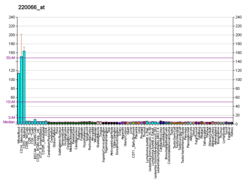Nucleotide-binding oligomerization domain-containing protein 2 (NOD2), also known as caspase recruitment domain-containing protein 15 (CARD15) or inflammatory bowel disease protein 1 (IBD1), is a protein that in humans is encoded by the NOD2 gene located on chromosome 16.[5][6] NOD2 plays an important role in the immune system. It recognizes bacterial molecules (peptidoglycans) and stimulates an immune reaction.[7]
NOD2 is an intracellular pattern recognition receptor, which is similar in structure to resistant proteins of plants and recognizes molecules containing the specific structure called muramyl dipeptide (MDP) that is found in certain bacteria.[8]
Structure
edit
The C-terminal portion of the protein contains a leucine-rich repeat domain that is known to play a role in protein–protein interactions. The middle part of the protein is characterized by a NOD domain involved in protein self-oligomerization. The N-terminal portion contains two CARD domains known to play a role in apoptosis and NF-κB activation pathways.[10]
Function
editThis gene is a member of the NOD1/Apaf-1 family (also known as NOD-like receptor family) and encodes a protein with two caspase recruitment domains (CARDs) and eleven leucine-rich repeats (LRRs). The protein is primarily expressed in the peripheral blood leukocytes. It plays a role in the immune response by recognizing the bacterial molecules which possess the muramyl dipeptide (MDP) moiety and activating the NF-κB protein.[11]
Clinical significance
editMutations in this gene have been associated with Crohn's disease,[9] Blau syndrome, severe pulmonary sarcoidosis[12] and Graft-versus-host disease.[13]
The NOD2 gene is linked to inflammatory diseases such as Inflammatory bowel disease/Crohn's disease, Yao Syndrome and Blau syndrome.[14][15]
Interactions
editNOD2 has been shown to interact with NLRC4.[16][17]
NOD2 has also been shown to bind to MAVS in response to ssRNA or viral RNA treatment and activate the IFN response. This is the first report of NOD2 acting as a pattern-recognition receptor for viruses.[18]
See also
edit- Mifamurtide, a NOD2 activator for the treatment of osteosarcoma
References
editFurther reading
edit- Punchard NA (Oct 2001). "Overview: Nod2, cause of, or contributor to, Crohn's disease". Current Opinion in Investigational Drugs. 2 (10): 1378–81. PMID 11890351.
- Satsangi J, Morecroft J, Shah NB, Nimmo E (Feb 2003). "Genetics of inflammatory bowel disease: scientific and clinical implications". Best Practice & Research. Clinical Gastroenterology. 17 (1): 3–18. doi:10.1053/bega.2002.0349. PMID 12617879.
- Rosenbaum JT, Planck SR, Davey MP, Iwanaga Y, Kurz DE, Martin TM (Oct 2003). "With a mere nod, uveitis enters a new era". American Journal of Ophthalmology. 136 (4): 729–32. doi:10.1016/S0002-9394(03)00569-5. PMID 14516815.
- Kurokawa T, Kikuchi T, Ohta K, Imai H, Yoshimura N (Oct 2003). "Ocular manifestations in Blau syndrome associated with a CARD15/Nod2 mutation". Ophthalmology. 110 (10): 2040–4. doi:10.1016/S0161-6420(03)00717-6. PMID 14522785.
- Girardin SE, Hugot JP, Sansonetti PJ (Dec 2003). "Lessons from Nod2 studies: towards a link between Crohn's disease and bacterial sensing". Trends in Immunology. 24 (12): 652–8. doi:10.1016/j.it.2003.10.007. PMID 14644139.
- Newman B, Siminovitch K (Dec 2003). "Inflammatory bowel disease: Crohn's disease and the success of NODern genetics". Clinical and Investigative Medicine. 26 (6): 303–14. PMID 14690304.
- Oostenbrug LE, van Dullemen HM, te Meerman GJ, Jansen PL (2003). "IBD and genetics: new developments". Scandinavian Journal of Gastroenterology. Supplement. 38 (239): 63–8. doi:10.1080/00855920310002717 (inactive 2024-04-11). PMID 14743885.
{{cite journal}}: CS1 maint: DOI inactive as of April 2024 (link) - Kambe N, Nishikomori R, Kanazawa N (Aug 2005). "The cytosolic pattern-recognition receptor Nod2 and inflammatory granulomatous disorders". Journal of Dermatological Science. 39 (2): 71–80. doi:10.1016/j.jdermsci.2005.04.001. PMID 15927452.
- Newman B, Siminovitch KA (Jul 2005). "Recent advances in the genetics of inflammatory bowel disease". Current Opinion in Gastroenterology. 21 (4): 401–7. PMID 15930978.
- Martinon F, Tschopp J (Aug 2005). "NLRs join TLRs as innate sensors of pathogens". Trends in Immunology. 26 (8): 447–54. doi:10.1016/j.it.2005.06.004. PMID 15967716.
- Strober W, Murray PJ, Kitani A, Watanabe T (Jan 2006). "Signalling pathways and molecular interactions of NOD1 and NOD2". Nature Reviews. Immunology. 6 (1): 9–20. doi:10.1038/nri1747. PMID 16493424. S2CID 33505741.
- Cavanaugh J (Jun 2006). "NOD2: ethnic and geographic differences". World Journal of Gastroenterology. 12 (23): 3673–7. doi:10.3748/wjg.v12.i23.3673. PMC 4087459. PMID 16773683.
- Hugot JP (Aug 2006). "CARD15/NOD2 mutations in Crohn's disease". Annals of the New York Academy of Sciences. 1072 (1): 9–18. Bibcode:2006NYASA1072....9H. doi:10.1196/annals.1326.011. PMID 17057186. S2CID 24150549.
- Vignal C, Singer E, Peyrin-Biroulet L, Desreumaux P, Chamaillard M (Apr 2007). "How NOD2 mutations predispose to Crohn's disease?". Microbes and Infection / Institut Pasteur. 9 (5): 658–63. doi:10.1016/j.micinf.2007.01.016. PMID 17379562.
- Quaglietta L, te Velde A, Staiano A, Troncone R, Hommes DW (May 2007). "Functional consequences of NOD2/CARD15 mutations in Crohn disease". Journal of Pediatric Gastroenterology and Nutrition. 44 (5): 529–39. doi:10.1097/MPG.0b013e31803815ee. PMID 17460484. S2CID 37476303.
- van der Linde K, Boor PP, Houwing-Duistermaat JJ, Crusius BJ, Wilson PJ, Kuipers EJ, de Rooij FW (Jun 2007). "CARD15 mutations in Dutch familial and sporadic inflammatory bowel disease and an overview of European studies". European Journal of Gastroenterology & Hepatology. 19 (6): 449–59. doi:10.1097/01.meg.0000236887.44214.6a. PMID 17489054. S2CID 17766170.





